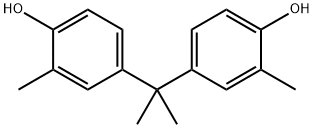
2,2-Bis(4-hydroxy-3-methylphenyl)propane
- русский язык имя
- английское имя2,2-Bis(4-hydroxy-3-methylphenyl)propane
- CAS №79-97-0
- CBNumberCB3282153
- ФормулаC17H20O2
- мольный вес256.34
- EINECS201-240-0
- номер MDLMFCD00002232
- файл Mol79-97-0.mol
| Температура плавления | 138-140 °C(lit.) |
| Температура кипения | 238-240 °C12 mm Hg(lit.) |
| плотность | 1.0421 (rough estimate) |
| давление пара | 0Pa at 25℃ |
| показатель преломления | 1.5000 (estimate) |
| растворимость | almost transparency in Methanol |
| форма | solid |
| форма | solid |
| пка | 10.45±0.10(Predicted) |
| цвет | White to Almost white |
| Растворимость в воде | 22mg/L at 20℃ |
| Стабильность | Hygroscopic |
| ИнЧИКей | YMTYZTXUZLQUSF-UHFFFAOYSA-N |
| LogP | 4.11 at 20℃ |
| Справочник по базе данных CAS | 79-97-0(CAS DataBase Reference) |
| Рейтинг продуктов питания EWG | 1 |
| FDA UNII | 98817I7XJ2 |
| Справочник по химии NIST | Phenol, 4,4'-(1-methylethylidene)bis[2-methyl-(79-97-0) |
| Система регистрации веществ EPA | Phenol, 4,4'-(1-methylethylidene)bis[2-methyl- (79-97-0) |
| UNSPSC Code | 85151701 |
| NACRES | NA.24 |
| Коды опасности | Xi | |||||||||
| Заявления о рисках | 36/37/38 | |||||||||
| Заявления о безопасности | 26-36 | |||||||||
| WGK Германия | 3 | |||||||||
| RTECS | GP1750000 | |||||||||
| кода HS | 29072990 | |||||||||
| Банк данных об опасных веществах | 79-97-0(Hazardous Substances Data) | |||||||||
| NFPA 704: |
|
рисовальное письмо(GHS)
-
рисовальное письмо(GHS)

-
сигнальный язык
предупреждение
-
вредная бумага
H315:При попадании на кожу вызывает раздражение.
H319:При попадании в глаза вызывает выраженное раздражение.
H335:Может вызывать раздражение верхних дыхательных путей.
-
оператор предупредительных мер
P261:Избегать вдыхания пыли/ дыма/ газа/ тумана/ паров/ аэрозолей.
P264:После работы тщательно вымыть кожу.
P271:Использовать только на открытом воздухе или в хорошо вентилируемом помещении.
P280:Использовать перчатки/ средства защиты глаз/ лица.
P302+P352:ПРИ ПОПАДАНИИ НА КОЖУ: Промыть большим количеством воды.
P305+P351+P338:ПРИ ПОПАДАНИИ В ГЛАЗА: Осторожно промыть глаза водой в течение нескольких минут. Снять контактные линзы, если Вы ими пользуетесь и если это легко сделать. Продолжить промывание глаз.
2,2-Bis(4-hydroxy-3-methylphenyl)propane химические свойства, назначение, производство
Описание
2,2-Bis(4-hydroxy-3-methylphenyl)propane is a monomer of polycarbonate and bisphenol A. It has been used as a reaction solution for sodium salt and calcium stearate. The product contains hydrogen chloride and hydrochloric acid as byproducts. This product also reacts with fatty acids to produce aromatic hydrocarbons.Химические свойства
Powder or crystalline or crystalline powder or chunksИспользование
Used as a color-developer in thermosensitive recording materials.Подготовка
The preparation of 2,2-Bis(4-hydroxy-3-methylphenyl)propane is as follows:In a full-jacket type 1 L separable flask equipped with a thermometer, a stirrer, and a 100 mL dropping funnel, 26.1 g (0.4 mol) of isopropyl alcohol was added under a nitrogen atmosphere, and then 58.3 g (0.5 mol) of 90% by weight sulfuric acid was slowly added thereto. Thereafter, 54.5 g of toluene, 191.5 g (1.8 mol) of ortho-cresol, and 5.5 g (0.03 mol) of dodecanethiol were added thereto, followed by setting the temperature in the separable flask to 40° C. In the dropping funnel, 42.5 g (0.7 mol) of acetone was placed, and it was slowly fed dropwise to the separable flask for 30 minutes. After completion of the dropwise addition of acetone, the reaction was allowed to proceed at 40° C. for 2 hours. After completion of the reaction, 100.0 g of toluene and 100.0 g of demineralized water were fed, and the temperature was increased to 80° C. After the temperature reached 80° C., the reaction liquid was left to stand to confirm that the precipitates generated during the reaction were dissolved into the organic phase and the aqueous phase. This was followed by extraction of the aqueous phase in the lower layer. Thereafter, saturated sodium hydrogen carbonate solution was added to the obtained organic phase to allow neutralization, followed by confirming that the pH of the aqueous phase in the lower layer, became not less than 9. After extraction of the aqueous phase in the lower layer, demineralized water was added to the obtained organic phase, and the resulting mixture was stirred for 10 minutes. Thereafter, the mixture was left to stand, and the aqueous phase was extracted. Part of the obtained organic phase was removed, and subjected to high-performance liquid chromatography to analyze the amount of bisphenol C produced. As a result, the reaction yield in terms of acetone was found to be 84 mol %.
2,2-Bis(4-hydroxy-3-methylphenyl)propane поставщик
| поставщик | телефон | страна | номенклатура продукции | благоприятные условия | |
|---|---|---|---|---|---|
| +8618602515822 | China | 77 | 58 | ||
| +86-051985861892 +8618112881323 |
China | 273 | 58 | ||
| +86-852-30606658 | China | 43340 | 58 | ||
| +86-371-86557731 +86-13613820652 |
China | 20259 | 58 | ||
| +86-(0)57185586718 +86-13336195806 |
China | 29792 | 60 | ||
| +86-371-66670886 | China | 19902 | 58 | ||
| +86-0371-55170693 +86-19937530512 |
China | 21632 | 55 | ||
| +86-0371-86658258 +8613203830695 |
China | 29809 | 58 | ||
| +86-13806087780 | China | 17365 | 58 | ||
| +86-0551-65418671 +8618949823763 |
China | 34563 | 58 |